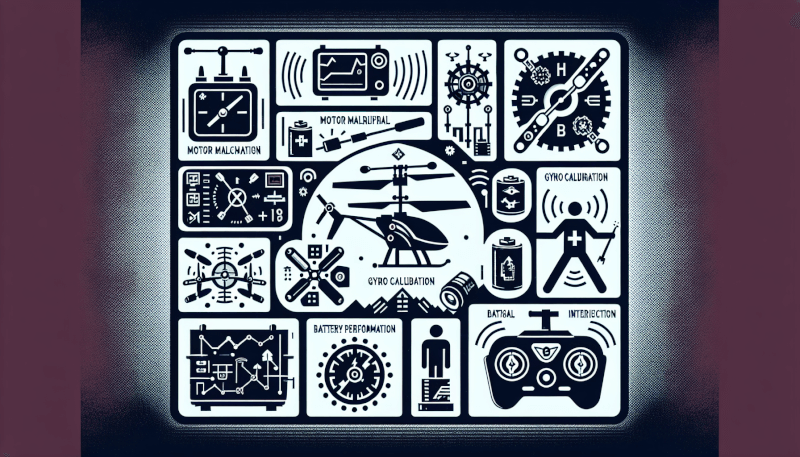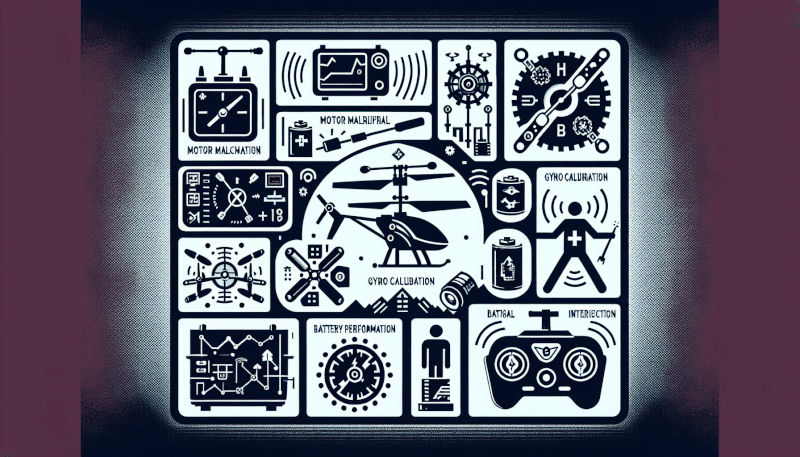Whether you’re a seasoned pilot or just starting out, flying remote control helicopters can be a thrilling and rewarding hobby. However, like any hobby, there can be some bumps along the way. From unexplained crashes to strange noises, troubleshooting common issues with your RC heli can sometimes feel like a frustrating puzzle. But fear not, because in this ultimate guide, we’ll walk you through the most common problems pilots encounter and provide you with practical solutions to get you back in the air in no time. So grab your toolbox and prepare to become an expert in diagnosing and fixing common RC heli issues!
1. Battery Issues
1.1 Battery draining quickly
If you find that your RC helicopter’s battery is draining quickly, there are a few potential causes to consider. First, make sure that you are using a fully charged and properly functioning battery. If the battery is old or damaged, it may not hold a charge as effectively, leading to quick draining. Additionally, check for any excessive power draw from other components of the helicopter. Some accessories or features, such as lights or extra motors, may consume more power and cause the battery to drain faster. Finally, consider the flying conditions and flight time. If you are consistently flying at high speeds or performing maneuvers that require more power, it is natural for the battery to drain more quickly.
1.2 Battery not charging
If your battery is not charging, there are a few troubleshooting steps you can take. First, ensure that the charger is properly connected to both the power source and the battery. Sometimes, a loose connection can prevent the battery from charging. If the connections are secure, check the charger itself to make sure it is functioning correctly. If possible, try using a different charger to see if that resolves the issue. If none of these steps work, it is possible that the battery itself is faulty and may need to be replaced.
1.3 Battery connector issues
If you are experiencing issues with the battery connector, such as intermittent power loss or difficulty connecting the battery to the helicopter, there are a few potential causes to consider. First, check the connector itself for any visible damage or debris. Sometimes, dirt or debris can accumulate in the connector, preventing a secure connection. If you notice any damage or debris, clean the connector thoroughly and ensure that it is free of any obstructions. If the connector is damaged, it may need to be replaced. Additionally, check the wiring leading to the connector for any signs of damage or fraying. If you notice any issues with the wiring, it is important to replace or repair it to ensure a safe and reliable connection.
2. Transmitter Problems
2.1 No power to transmitter
If your transmitter is not receiving power, there could be a few potential causes. First, check the batteries in the transmitter to make sure they are properly installed and not depleted. If the batteries are old or low on power, they may need to be replaced. Additionally, check the battery contacts in the transmitter for any signs of dirt or corrosion. If necessary, clean the contacts with a soft cloth and contact cleaner to ensure a reliable connection. If none of these steps work, it is possible that there is an issue with the internal circuitry of the transmitter, and it may need to be repaired or replaced.
2.2 Signal loss
If you are experiencing signal loss between the transmitter and the helicopter, there are a few potential causes to consider. First, check the range of the transmitter and make sure you are within the recommended distance for reliable communication. Additionally, check the antenna on both the transmitter and the receiver for any signs of damage or poor connection. If the antenna is damaged, it may need to be replaced. If the antenna is securely attached, try adjusting its position to see if that improves the signal strength. Finally, ensure that there are no obstructions or interference sources in the area that could be affecting the signal.
2.3 Interference issues
Interference can cause erratic behavior or loss of control in your RC helicopter. If you suspect interference is the issue, there are a few steps you can take to troubleshoot. First, make sure that there are no other electronic devices operating on the same frequency as your transmitter. Other devices, such as Wi-Fi routers or cordless phones, can potentially interfere with the signal. If possible, try moving to a different location or turning off nearby electronics to see if that resolves the issue. Additionally, make sure that the transmitter and receiver are properly paired and that there are no loose connections. Lastly, consider investing in a transmitter with a higher frequency or better filtering capabilities to reduce the chances of interference.

3. Motor Malfunctions
3.1 Motor not spinning
If you find that one or more motors on your RC helicopter are not spinning, there are a few potential causes to consider. First, check the connections between the motor and the flight control board. If the connections are loose or damaged, it can prevent the motor from receiving the proper signals to spin. Make sure all the connections are secure and free of debris or corrosion. Additionally, check the motor itself for any signs of damage or wear. If the motor is damaged, it may need to be replaced. If none of these steps work, there may be an issue with the flight control board or the motor controller, and they may need to be inspected and repaired by a professional.
3.2 Motor heating up
If your motor is heating up excessively during flight, it is important to address the issue to prevent damage or failure. First, make sure that the motor is not overworked. If you are consistently flying at high speeds or performing maneuvers that require a lot of power, it is natural for the motor to heat up. However, if the motor is heating up even under normal flying conditions, there may be an issue with the motor itself or the power distribution system. Check the motor for any signs of damage or wear, as well as the wiring and connectors leading to the motor. Additionally, make sure that the power distribution system is functioning correctly and delivering the proper voltage to the motor. If necessary, consult with a professional to inspect and repair the motor or power system.
3.3 Motor making strange noises
If you hear unusual or strange noises coming from the motor of your RC helicopter, there could be a few potential causes. First, check the motor for any signs of debris or foreign objects that may be causing the noise. Sometimes, dirt or debris can accumulate in the motor and cause it to make unusual sounds. If you notice any debris, carefully clean the motor and ensure that it is free of any obstructions. Additionally, check the motor for any signs of damage or wear. If the motor is damaged, it may not spin smoothly and can make strange noises. Finally, examine the motor controller and the wiring leading to the motor for any signs of damage or loose connections. If necessary, consult with a professional to diagnose and repair the issue.
4. Gyro and Servo Troubles
4.1 Unstable flight
If your RC helicopter is experiencing unstable flight, the gyro and servos could be the cause. First, check the gyro settings to ensure they are properly calibrated for your helicopter. A misaligned or improperly calibrated gyro can cause instability in flight. Consult the manual or manufacturer’s instructions for specific guidance on gyro calibration. Additionally, check the servos for any signs of damage or wear. If the servos are not operating smoothly or are not responding accurately to control inputs, they may need to be replaced. Finally, ensure that the servo connections to the flight control board are secure and free of any debris or corrosion. Loose connections can cause erratic servo behavior and contribute to unstable flight.
4.2 Servo twitching
Servo twitching is a common issue in RC helicopters and can be caused by a few different factors. First, check the connections between the servos and the flight control board. Loose or damaged connections can cause intermittent twitching. Ensure that all connections are secure and free of any debris or corrosion. If the connections are good, check the servo for any signs of damage or wear. If the servo gears or motor are worn or damaged, they may need to be replaced to resolve the twitching issue. Finally, check the power supply to the servos. Inadequate voltage or power fluctuations can cause servo twitching. Make sure the power supply is stable and capable of delivering the required voltage to the servos.
4.3 Gyro drift
Gyro drift is the tendency of the RC helicopter to gradually lose its orientation or stability over time. If you notice gyro drift in your helicopter, there are a few potential causes to consider. First, check the gyro calibration. Improper gyro calibration can contribute to drift. Consult the manual or manufacturer’s instructions for specific guidance on gyro calibration. Additionally, check for any external factors that may be affecting the gyro’s performance. Environmental conditions, such as wind or electromagnetic interference, can cause gyro drift. If possible, try flying the helicopter in a different location or away from potential sources of interference to see if that resolves the issue. If the problem persists, there may be an issue with the gyro itself, and it may need to be inspected and repaired by a professional.

5. Receiver Connection Issues
5.1 Receiver not binding
If your receiver is not binding properly with the transmitter, there are a few potential causes to consider. First, check the compatibility between the transmitter and the receiver. Make sure they are designed to work together and are operating on the same frequency. Additionally, make sure that the transmitter and receiver are within close proximity and that there are no obstructions blocking the signal. If none of these steps work, there may be an issue with either the transmitter or the receiver, and they may need to be inspected and repaired or replaced.
5.2 No response from controls
If your controls are not responding when using the transmitter, there are a few potential causes to consider. First, check the batteries in the transmitter to make sure they are properly installed and not depleted. If the batteries are low on power, they may need to be replaced. Additionally, check the connection between the transmitter and the receiver. Loose or damaged connections can prevent the controls from transmitting the signals properly. Ensure that all connections are secure and free of debris or corrosion. If the problem persists, there may be an issue with either the transmitter or the receiver, and they may need to be inspected and repaired or replaced.
5.3 Loose receiver connection
If you notice that the receiver connection is loose, it is important to address the issue to prevent loss of control during flight. First, check the connections between the receiver and the flight control board. Ensure that all connections are secure and free of any debris or corrosion. If the connections are loose, tighten them carefully without overtightening. Additionally, check the wiring leading to the receiver for any signs of damage or wear. If you notice any issues with the wiring, it may need to be replaced or repaired. Finally, make sure that the receiver is properly mounted in the helicopter. A loose or unstable receiver can cause intermittent loss of control and should be secured properly.
6. Blade Balance Problems
6.1 Heli vibrating excessively
If your helicopter is vibrating excessively during flight, it can indicate an issue with blade balance. First, check the blades for any signs of damage or warping. Damaged or warped blades can cause vibration and should be replaced. Additionally, ensure that the blades are securely attached to the rotor head and are tight. Loose blades can cause imbalance and vibration. If the blades are securely attached and not damaged, try balancing them. Balancing the blades involves adding small weights to the blades to distribute the weight evenly and reduce vibration. There are various balancing tools and techniques available for this purpose. Finally, check the rotor head for any signs of wear or damage. If the rotor head components are worn or damaged, they may need to be replaced to resolve the vibration issue.
6.2 Heli drifting in flight
If your helicopter is drifting in flight, it can indicate an issue with blade balance. First, check the blades for any signs of damage or warping. Damaged or warped blades can cause uneven lift and contribute to drifting. If the blades are not damaged, try balancing them. Balancing the blades involves adding small weights to the blades to distribute the weight evenly and improve stability. There are various balancing tools and techniques available for this purpose. Additionally, check the rotor head for any signs of wear or damage. If the rotor head components are worn or damaged, they may need to be replaced to resolve the drifting issue. Finally, ensure that the helicopter is properly trimmed and adjusted for stable flight. Incorrect trim settings or misaligned controls can contribute to drifting.
6.3 Blades out of track
If your helicopter’s blades are out of track, it means that they are not rotating in the same plane and can cause stability issues during flight. To address this issue, start by checking the blades for any signs of damage or warping. Damaged or warped blades can contribute to the out-of-track problem and should be replaced. Additionally, ensure that the blades are properly installed and securely attached to the rotor head. Loose or improperly installed blades can cause imbalance and lead to tracking issues. If the blades are undamaged and properly installed, check the rotor head for any signs of wear or damage. If the components of the rotor head are worn or damaged, they may need to be replaced to resolve the tracking issue. Finally, consult the helicopter’s manual or manufacturer’s instructions for specific guidance on adjusting and aligning the blades for proper tracking.

7. Remote Control Calibration
7.1 Throttle calibration issues
If you are experiencing throttle calibration issues with your RC helicopter, there are a few potential causes to consider. First, make sure that the throttle range on your transmitter is properly calibrated for your helicopter. Consult the manual or manufacturer’s instructions for specific guidance on throttle calibration. Additionally, check the receiver and the flight control board for any signs of damage or loose connections. A faulty receiver or flight control board can prevent accurate throttle calibration. If necessary, consult with a professional to inspect and repair or replace the faulty components. Finally, ensure that all other settings and controls on the transmitter are properly calibrated and adjusted for your helicopter. Incorrect settings in other areas can affect the throttle calibration.
7.2 Trim adjustments not working
If you find that the trim adjustments on your transmitter are not working effectively, there are a few potential causes to consider. First, check the transmitter for any signs of damage or wear. A faulty or worn transmitter can prevent proper trim adjustments. If necessary, consult with a professional to inspect and repair or replace the transmitter. Additionally, check the flight control board and the servo connections for any signs of damage or loose connections. Faulty or loose connections can prevent the trim adjustments from being accurately transmitted to the helicopter. If the problem persists, there may be an issue with the flight control board or the servos, and they may need to be inspected and repaired or replaced.
7.3 Calibration not saving
If your calibration settings are not saving on the flight control board, there are a few potential causes to consider. First, check the flight control board for any signs of damage or wear. A faulty or worn flight control board can prevent the calibration settings from being saved. If necessary, consult with a professional to inspect and repair or replace the flight control board. Additionally, ensure that you are following the proper calibration procedure for your specific helicopter model. Different helicopters may require different steps for calibration, so consult the manual or manufacturer’s instructions for specific guidance. Finally, check the connection between the flight control board and the receiver for any signs of damage or loose connections. Faulty or loose connections can prevent the calibration settings from being accurately transmitted and saved.
8. Antenna Troubleshooting
8.1 Broken antenna
If your antenna is broken or damaged, it can significantly affect the signal strength and range of your RC helicopter. To troubleshoot this issue, start by inspecting the antenna for any visible damage or wear. If the antenna is bent, frayed, or has any other signs of damage, it may need to be replaced. Additionally, check the connection between the antenna and the transmitter or receiver for any signs of damage or loose connections. Faulty or loose connections can hinder the antenna’s performance. Finally, ensure that the antenna is properly positioned and not obstructed by any other components or structures. A clear antenna path can improve signal transmission and range.
8.2 Weak signal strength
If you are experiencing weak signal strength with your RC helicopter, there are a few potential causes to consider. First, check the antenna on both the transmitter and the receiver for any signs of damage or poor connection. If the antenna is damaged, it may need to be replaced. If the antenna is securely attached, try adjusting its position to see if that improves the signal strength. Additionally, check the transmitter and receiver for any signs of damage or wear that may affect signal transmission. If necessary, consult with a professional to inspect and repair or replace the faulty components. Finally, make sure that there are no obstructions or interference sources in the area that could be affecting the signal. A clear line of sight between the transmitter and receiver can improve signal strength.
8.3 Antenna routing errors
Improper antenna routing can cause signal interference and weakened performance in your RC helicopter. To troubleshoot this issue, check the routing of the antenna on both the transmitter and the receiver. Ensure that the antenna is positioned away from other components or structures that may interfere with signal transmission. Make sure that the antenna is properly attached and securely routed to prevent it from coming loose during flight. If you notice any errors or issues with the antenna routing, adjust it carefully to improve signal transmission and overall performance.

9. ESC (Electronic Speed Control) Problems
9.1 ESC not arming
If your ESC is not arming, preventing the motors from spinning, there are a few potential causes to consider. First, check the connection between the ESC and the flight control board. A loose or damaged connection can prevent the ESC from receiving the proper signals to arm. Ensure that all connections are secure and free of any debris or corrosion. Additionally, check the power supply to the ESC. Inadequate voltage or power fluctuations can prevent the ESC from arming. Make sure the power supply is stable and capable of delivering the required voltage to the ESC. If the problem persists, there may be an issue with either the ESC or the flight control board, and they may need to be inspected and repaired or replaced.
9.2 ESC overheating
If your ESC is overheating during flight, it is important to address the issue to prevent damage or failure. First, check the airflow around the ESC. Proper cooling is essential to prevent overheating. Ensure that the ESC is not obstructed by any other components or structures that may impede airflow. Additionally, check the power supply to the ESC. Inadequate voltage or power fluctuations can cause the ESC to overheat. Make sure the power supply is stable and capable of delivering the required voltage to the ESC. If the problem persists, there may be an issue with the ESC itself, and it may need to be inspected and replaced with a more robust model.
9.3 ESC stuttering
If your ESC is stuttering, causing erratic motor behavior, there are a few potential causes to consider. First, check the connection between the ESC and the flight control board. A loose or damaged connection can cause the ESC to receive inconsistent signals, leading to stuttering. Ensure that all connections are secure and free of any debris or corrosion. Additionally, check the power supply to the ESC. Inadequate voltage or power fluctuations can cause the ESC to stutter. Make sure the power supply is stable and capable of delivering the required voltage to the ESC. If the problem persists, there may be an issue with either the ESC or the flight control board, and they may need to be inspected and repaired or replaced.
10. Troubleshooting Flight Control Boards
10.1 Flight controller not initializing
If your flight control board is not initializing properly, preventing the helicopter from starting, there are a few potential causes to consider. First, check the power supply to the flight control board. Inadequate voltage or power fluctuations can prevent the board from initializing. Make sure the power supply is stable and capable of delivering the required voltage to the board. Additionally, check the connections between the flight control board and other components, such as the receiver, motors, and sensors. Loose or damaged connections can interfere with the initialization process. Ensure that all connections are secure and free of any debris or corrosion. Finally, if the issue persists, there may be an issue with the flight control board itself, and it may need to be inspected and replaced.
10.2 Erratic flight behavior
If your RC helicopter is exhibiting erratic flight behavior, such as sudden changes in altitude or unpredictable movements, there may be an issue with the flight control board. First, check the calibration settings on the flight control board. Improper calibration can contribute to erratic flight behavior. Consult the manual or manufacturer’s instructions for specific guidance on calibration. Additionally, check the connections between the flight control board and other components, such as the receiver, motors, and sensors. Loose or damaged connections can cause intermittent signals and contribute to erratic behavior. Ensure that all connections are secure and free of any debris or corrosion. If the problem persists, there may be an issue with the flight control board itself, and it may need to be inspected and replaced.
10.3 Firmware update failure
If you encounter a firmware update failure when trying to update the flight control board, there are a few potential causes to consider. First, ensure that you are using the correct firmware for your specific flight control board model. Using the wrong firmware can cause the update process to fail. Consult the manual or manufacturer’s instructions for specific guidance on firmware updates. Additionally, make sure that the flight control board is properly connected to your computer or other device for the update process. Loose or faulty connections can prevent the update from completing successfully. If the problem persists, contact the manufacturer or consult a professional for further assistance with the firmware update process.



